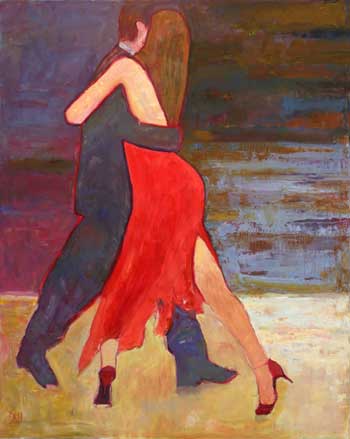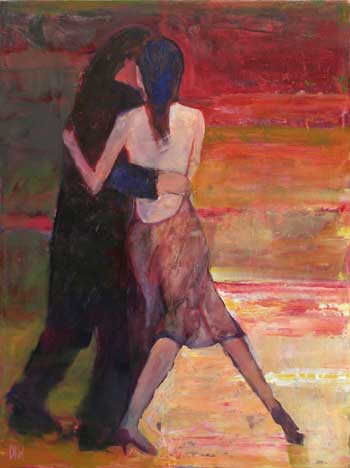This session of Tango Fundamentals, we've been working on building balance, connection and energy with our partners. We've also worked on starting and exiting turns in different ways, as well as spiffing up our traveling back ochos. Here's what we've covered in the first three weeks of class:
Balance, connection and energy
- Energy flow drill: This drill teaches you to be aware of the energy and motion of everyone dancing in the room. As a good leader, you must know this in order to successfully and safely lead the follower around the dance floor. As a follower, being aware of this helps you be a responsible dancer (i.e. limiting your boleo height, restraining big adornos in a crowd, etc.). In the energy flow drill, we all move through the available space (in any direction), and try to remain constantly in motion. If someone is in the way, we turn, rather than pausing. If there is space somewhere else in the room, we go where there is space. In "real life" tango situations, there are cultural rules that prevent us from having this much freedom: we dance counter-clockwise in the room; we don't pass the couple in front of us; we maintain "lanes" of movement. However, by remaining aware of the space around us, and how the entire room of people is moving, we can plan ahead better and avoid accidents.
- Solo-couple drill: This game teaches you to get connected to your partner quickly. Once the energy flow of the room is working, we move through the space in couples. In Solo-Couple, the teacher calls "Solo!" and everyone does the energy flow drill. When the teacher calls "Couple!" everyone grabs the nearest dancer, and WITHOUT STOPPING, continues to dance around the room. Again, in "real life" tango, there is time to cabeceo, approach the dance floor, take your space, embrace your partner, and then start dancing. However, in festival situations, there is no space to spend time on all of this, and you need to get on the floor, connect, and start dancing within about 30 seconds if you don't want to be run over! This drill gets the dancers to tune in to their surroundings in order to successfully survive joining a tanda in full swing.
- Energy bunnies and energy vampires: This game helps you maintain your energy on the dance floor throughout the evening. I don't remember which of my students at the University of Oregon named this game/drill, but I've kept the names because everyone laughs when we do this! Obviously, this is an energy game: take energy from the people around you if you are tired, or give energy to the room/your partner if you are energized. On each dance floor, there is a level of energy present. Sometimes, the room's energy gives the dancers energy; sometimes not. In this game, we move through space in any direction, and make sound effects/motions to send energy to everyone we pass. Then, we move around, taking energy away (little sucking noises and vampire faces seem to be the favorites). I have found that everyone in the room has a higher energy level after this game, and use it in class to wake folks up; on the dance floor, I use this energy-building skill to be able to keep dancing, hour after hour (I don't make the noises and faces then!).
- Naughty Toddler: This game helps the follower give energy to the leader, and teaches the leader to use the energy as a way to improvise on the dance floor. Just as it is easier to divert a toddler than to stop unwanted behavior, it is easier to redirect a follower than to wrestle with them. The follower does not follow in this game: s/he does whatever moves come to mind, tango or non-tango. The leader holds on with both hands, and tries to use the follower's energy to get around the dance floor without collisions. As the leader figures out how to steer the "toddler" this game becomes "my chi is bigger than your chi" as the leader reads the energy and PREVENTS the "toddler" from misbehaving by leading clearly with the energy present in the dance: by the end of the game, the leader should feel mostly in control AND the follower should have felt led, but not wrestled.
- Posture work: floor, sitting, standing. We start lying on the floor, feet flat on floor and knees up (in skirts, face a non-mirrored wall). Feel how relaxed your spine and hips are! Feel how your spinal alignment works when not fighting gravity. Now, sit up (cross-legged on floor, or in a chair if you lack flexibility). Try to recreate the same alignment as on the ground. Third, stand up and again recreate the floor alignment, adding the complexity of adjusting your pelvis for standing. The more you do these three steps, the more your alignment will remain relaxed AND in position when you move in tango.
- Breath work: axis and force field. I do the axis drill after completing the postural work. Standing in place, alone, on axis, close your eyes. Breathe and imagine the air can come up from below the floor, up through your body, to your lungs. When you exhale, send the breath back down through your feet, as if you are pushing a magnet away beneath the floor. After a few breaths, change the exhale to go up through the top of your head and up to the ceiling. Third, exhale and inhale with the same amount of energy and breath coming in from the feet and head; and exhaling 50-50 as well. In the force field drill, face partner close enough to be in their personal space, but not touching. Do the axis drill, but when you exhale, also send energy/light/electricty/your favorite color/etc. straight out your toes, through your partner, and to the wall beyond them. After a few breaths, expand that to a rectangle of energy from the toes and knees; expand to the hips; add up to the belly button; now up to the ribcage; next, include the shoulder blades and collar bones; finally, the entire body sends a rectangular force field through the partner, to the wall beyond. When this is in place, move in to an embrace and dance with your partner, eyes closed. On each exhale, move. On each inhale, pause. Keep the force field working.
- Energy work: directing movement from the solar plexus. We moved across the floor, met a partner, and kept sending our energy across the room, slightly up and through the partner (there were interesting interpretations of this, but we'll leave that for later ;-)). In order for you to NEVER step on your partner's feet, you need to send your energy forward into their body. The solar plexus should never point down, or your partner's feet will suddenly be in your way. Followers: remember to send the energy TOWARDS the leader, rather than "escaping" away; it will save your toes!
Steps
Turns: Last session, we concentrated on turning after reaching the cross (la cruzada). This time, we expanded our ways of getting into a turn.
- right (clockwise, CW) after side step (follower's first step of the turn is a front or back cross step with the right foot)
- left (counter-clockwise, CCW) after side step (follower's first step of the turn is a front or back cross step with the left foot)
- right (CW) after rock step (follower's first step of the turn is a front cross step with the right, across the leader's body)
- left (CCW) after rock step (follower's first step is a front cross step with the left, across the leader's body)
- rock step and left (CCW) turn (follower's first step is an open step around the leader with the right foot)--this is NOT the same as starting the turn FROM the rock step. Here, the leader leads a rock step so that the follower's RIGHT foot is free; thus the turn starts with an open step for the follower.
- at the cross (@X), right (CW) or left (CCW) turn (follower's first step is either a front cross or an open step, with the right foot.
Traveling back ochos: There are many ways to do this step. I advocate a smooth, elegant, sexy version that allows the follower to pivot slightly and adjust in the hips, while the leader basically walks forward.
- Get into crossed system: I prefer stepping forward-together-forward, rather than side-together-forward here. I feel that the follower gets a clearer signal if the first step is line-of-dance (LOD), rather than sideways.
- Leader walks in a SLIGHTLY wider stance, but keeping the V of the feet facing LOD and the hips facing LOD. This is not a time to start waddling ;-)
- The leader's chest moves in a natural, cross-body motion in order to walk. No more motion is needed here. If you tend to be rigid in your torso, you may have to work on this rotation around your spine in order to make your walk more elegant and easier on your body.
- The follower's body also uses cross-body motion in order to walk backwards. Because you are now in crossed system, the follower's free leg NATURALLY crosses behind the other leg. The hips adjust and pivots slightly, as do the feet, to make this look pretty and to remove stress on the spine. Take care not to overturn in this move (in open embrace, a bit more rotation can be used for a more zig-zag style of ocho, but I personally prefer this one.
- To exit, walk to the cross in crossed system, resolving at the cross. Alternatively, you can exit by turning CW or CCW into a turn. I don't usually lead back into parallel walks to exit because it isn't very elegant. Also, when do you ever have space to walk traveling back ochos and then keep walking? :-)
This week, we'll be adding walking to the outside track, in parallel and crossed systems, and playing with the "forgotten" side of tango. See you in class!



